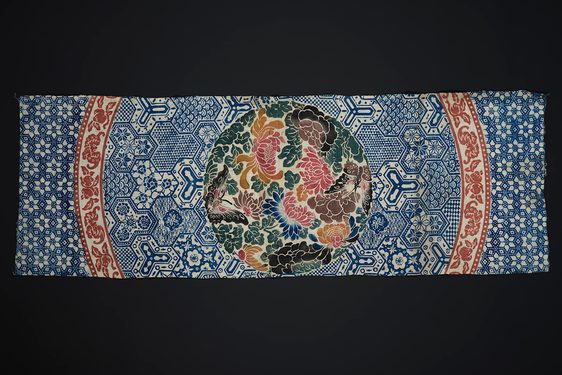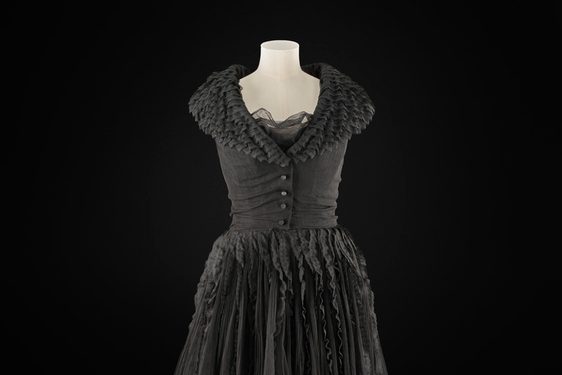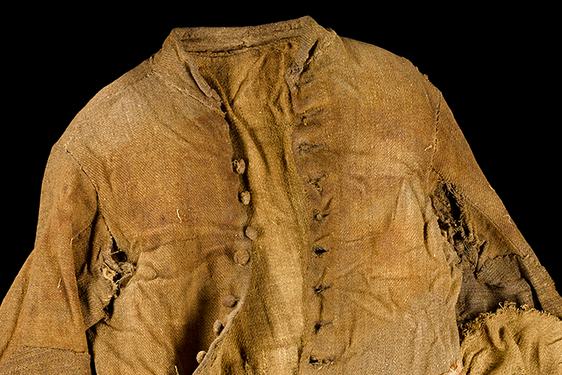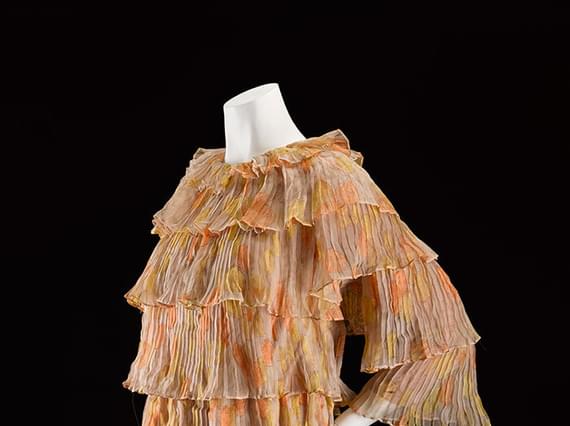
The signature styles of designer Jean Muir
News Story
In a fashion career spanning more than 40 years, Jean Muir acquired a reputation for restrained, elegant design and a devoted following. We chart 12 signature styles from the Jean Muir archive and uncover what made her designs so innovative and enduring.
You don’t go about being in fashion in Jean Muir, you go about being in Jean Muir, which is kind of beyond fashion, you know.
Joanna Lumley, former house model and muse
Who was Jean Muir?
Born in London in 1928, Muir left school at 17. After working briefly in office jobs, she began her career in fashion as a stockroom assistant at Liberty & Co in 1950. She quickly transferred to the lingerie and Young Liberty sections where she worked selling and sketching. Muir was a prolific home dressmaker and attended fashion illustration classes. In 1956 she moved to Jaeger as a designer, where she developed a youth range.
In 1962, Muir left Jaeger to design her first independent collection under the Jane & Jane label. In 1966, she founded Jean Muir Ltd with her husband, Harry Leuckert.
The Jean Muir archive
Jean Muir's father hailed from Aberdeen, and she was immensely proud of her Scottish heritage. Before her death she had started fundraising for National Museums Scotland, and in 2005 her husband Harry donated the Jean Muir archive to the national collections.
The archive consists of around 18,000 objects which fully document the design, making, and promotion of Muir’s collections from 1966 to 1995. The collection includes paper patterns, sketches, fabric samples, jewellery and accessories, as well as around 400 finished garments, including some of her personal clothing.
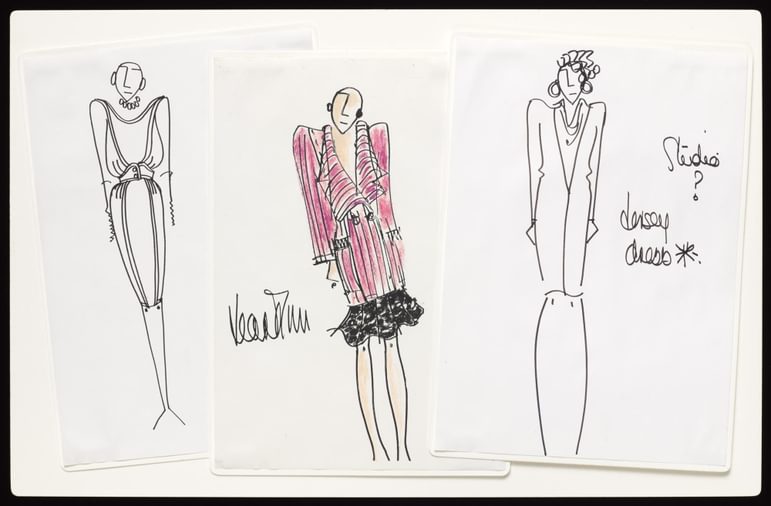
Series of three original sketches in ink and oil pastel on paper, mounted on board, depicting dress designs on three female figures: British, by Jean Muir Ltd, c. 1966-95. Museum reference K.2005.649.1317.
1. Modern mood
From the first Jane & Jane designs onwards, Muir created feminine garments with simple silhouettes. They were designed to flatter the female form and to move freely with the wearer.
Muir loved modern shapes and this pleated, tiered silk chiffon dress captures the youthful 1960s fashion mood.
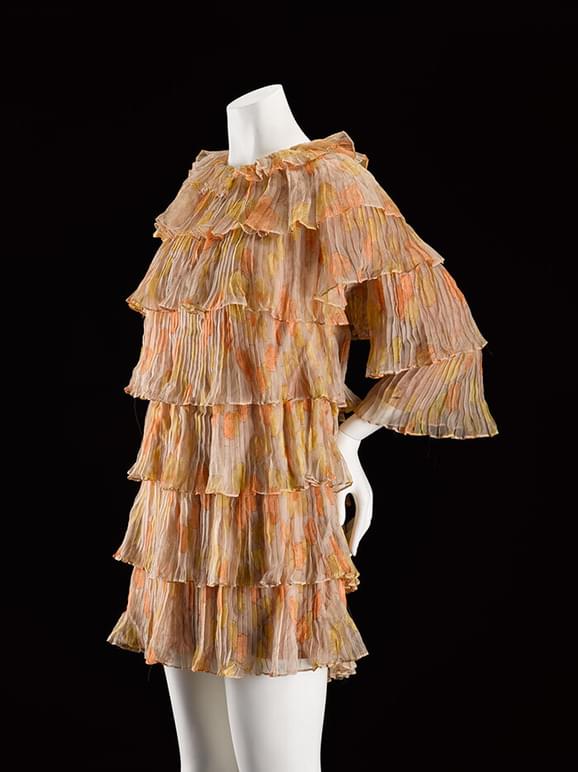
Pleated silk chiffon dress, 1962-66. Museum reference K.2005.649.869.
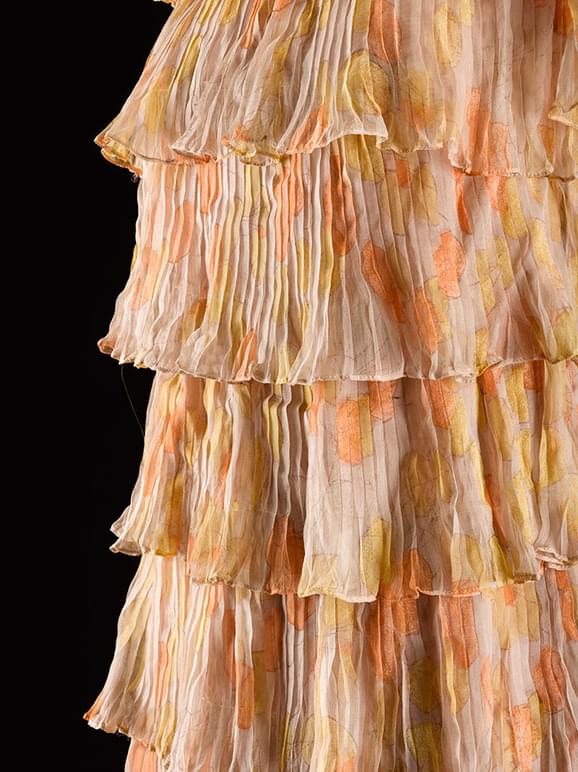
Detail of pleated silk chiffon dress, 1962-66. Museum reference K.2005.649.869.
2. LBD
This elegant black Jane & Jane dress once belonged to actor Joanna Lumley. It was not only her first Jean Muir purchase after becoming her house model in 1964, it was also her first 'little black dress'.
For me, the ultimate practitioner of perfect LBD chic was the late Jean Muir. With just a few metres of black jersey, Miss Muir could conjure up a dress, which was a master-class in elegance and refinement.
Iain R Webb, fashion journalist
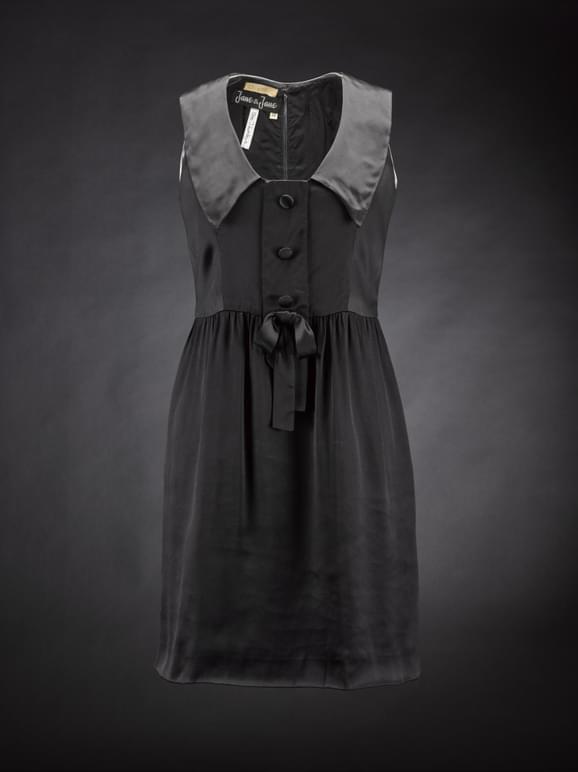
Black satin mini dress, c.1964. Museum reference K.2012.102.
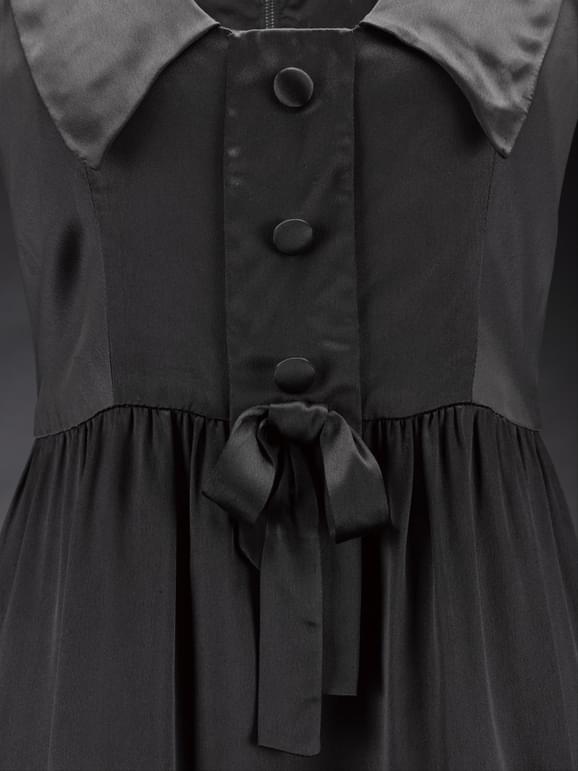
Detail of black satin mini dress, c.1964. Museum reference K.2012.102.
3. Jersey
Muir particularly enjoyed working with jersey. This fabric doesn’t need to be hand-sewn or lined, or the edges bound to neaten them, but can be given an extraordinary architectural structure despite its supple qualities.
This dress features all the quintessential elements of Muir’s work: navy blue matte jersey, pin-tucking across the chest yoke, top-stitching, decorative buttons and the precise cut, fit and flare for which her jersey dresses were much admired.
Miss Muir wanted the darkest navy we had ever produced, rejecting various samples before declaring a cutting of black crêpe to be the right shade… It turned out to be a new ‘best seller’, known in the trade as ‘new black’ whilst to Miss Muir it was ‘midnight navy’.
John Knox, John Knox & Sons, latterly Aire Valley Mills
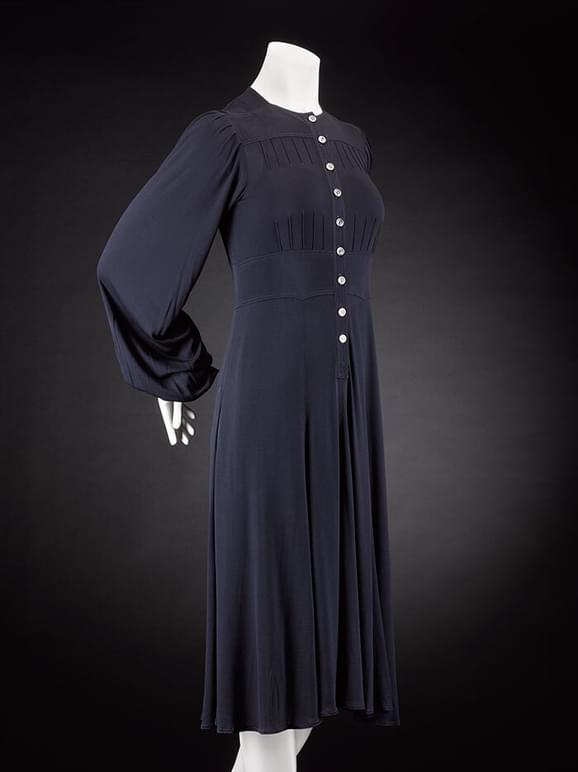
Viscose matte jersey dress, c.1972. Museum reference K.2005.649.181.
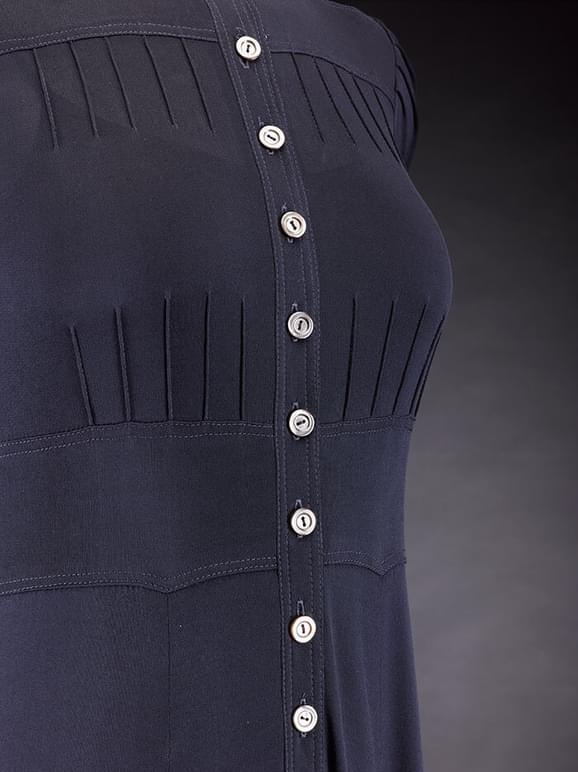
Detail of viscose matte jersey dress, c.1972. Museum reference K.2005.649.181.
4. Colour
Muir is famous for her use of navy and black, but she was also a fantastic colourist. Here the piecing together of the coloured panels are accentuated by her signature top-stitching.
The romantic style of this dress is typical of the 1970s, enhanced by Muir’s characteristic use of matte jersey and the clever gathering of the fabric below the waist to create a fuller skirt. Joanna Lumley was famously photographed by Michael Barrett in a similarly colourful, flowing jersey dress.
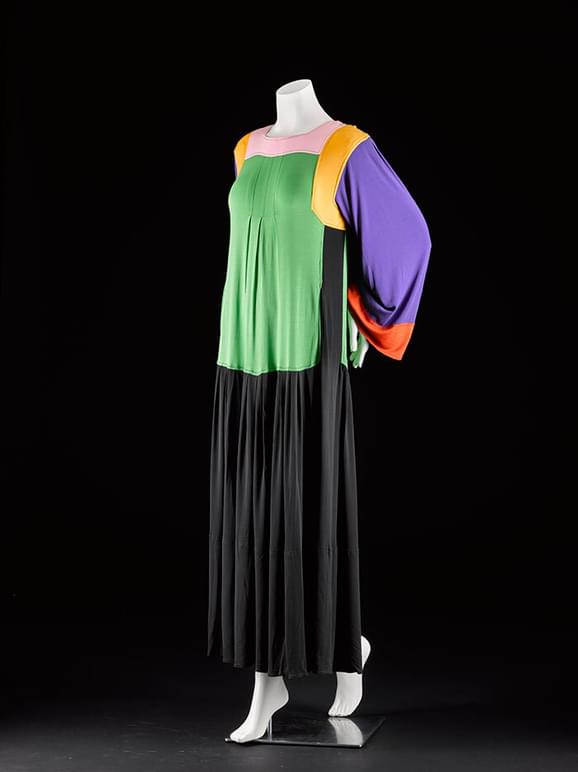
Viscose matte jersey dress, early 1970s.
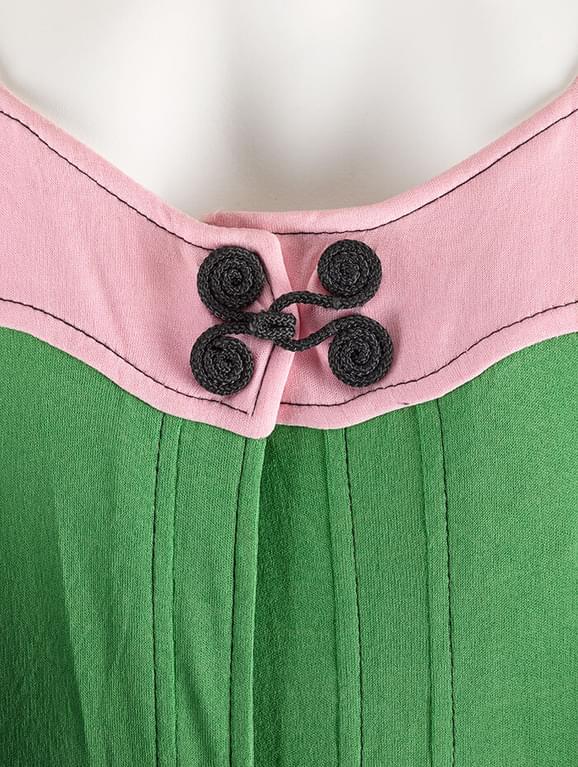
Detail of viscose matte jersey dress, early 1970s.
5. Sheer femininity
Muir’s use of prints gave her collections vibrancy. She favoured supple fabrics, such as this silk georgette, which took the pigment well but also responded beautifully to a woman’s body. This maxi-dress is enlivened by the bold leaf print, echoed in the sequin embellishment at the neckline and cuffs.
Although Muir’s dresses appeared simple in shape, they were always intricately made and were the result of fastidious attention to detail. This is seen in the tiers of chiffon in this dress which are hemmed with lines of top-stitching.
She was just… the best at dresses that ever happened and I think that’s why she called herself a dressmaker. She made the most extraordinary, fluid and incredible dresses. One of the things that occurred to me is that people will go on wearing those dresses for years and she must have realised that.
Mary Quant, fashion designer
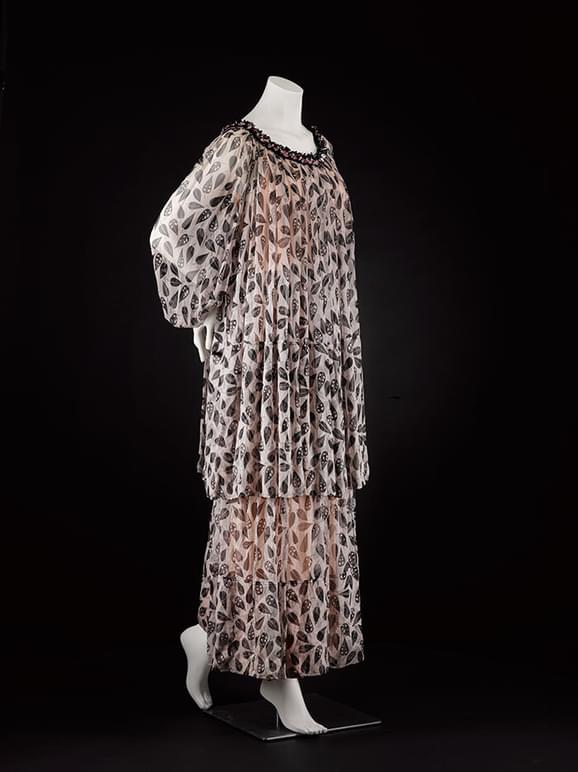
Silk georgette dress, 1970s. Museum reference K.2005.649.638.
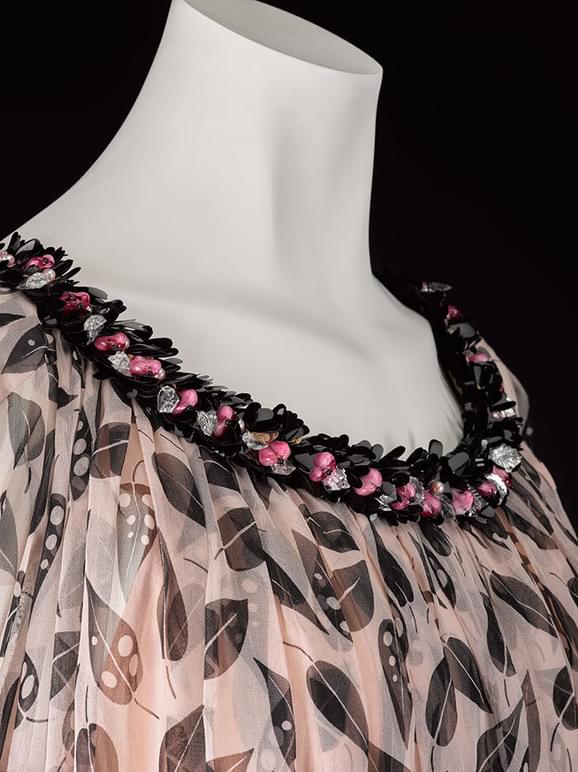
Detail of silk georgette dress, 1970s. Museum reference K.2005.649.638.
6. Clever cutting
Muir’s work in suede often featured experimental cutting, hand-punching, printing, and a beautiful use of colour. This very feminine jacket demonstrates her technical excellence, with the use of clever cutting and pleating to create the full sleeve shape.
Muir had a tendency to carry characteristic details of each season’s designs across the collection. Motifs printed onto jersey would be hand-punched or stamped into suede, bringing a unity to her work and helping to define the Jean Muir look.
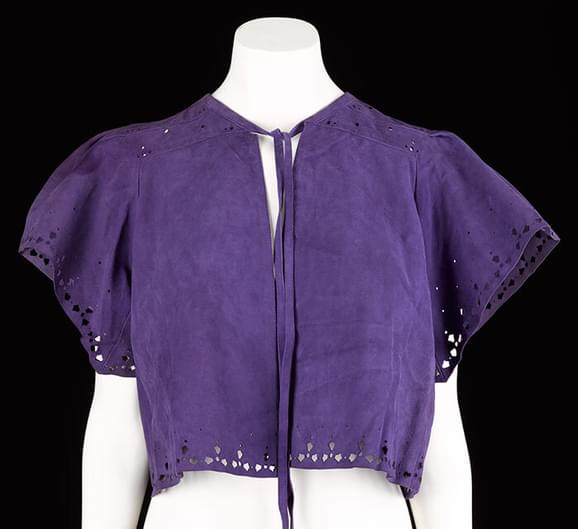
Suede shirt, probably early 1970s. Museum reference K.2005.649.591.
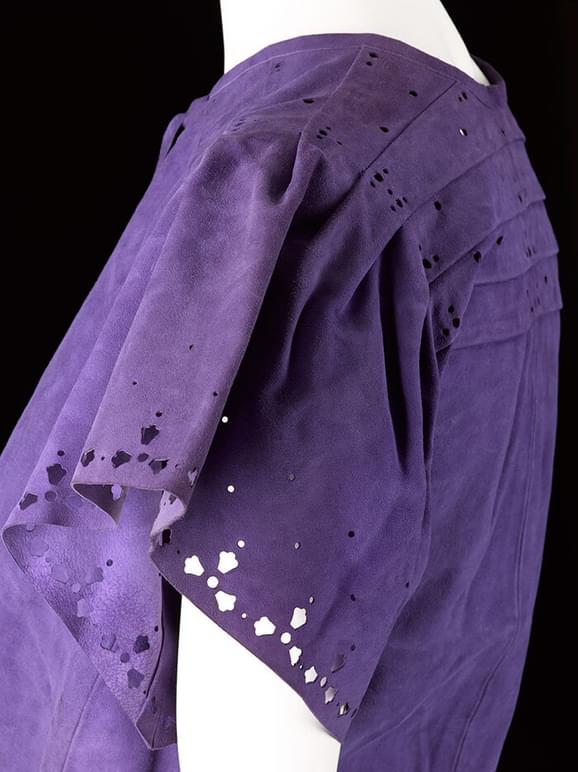
Detail of suede shirt, probably early 1970s. Museum reference K.2005.649.591.
7. Tailoring
Tailored garments in wool crêpe were a Jean Muir speciality. The fabric is made from yarns with a very high twist, which produces a distinctive, textured appearance. Crisp enough to hold its shape, but soft enough to move with the body, it is ideally suited to Muir’s technically complex yet deceptively simple designs. The curved cut of the double-breasted front of this jacket adds a typically feminine twist to Muir’s version of a menswear-inspired design.
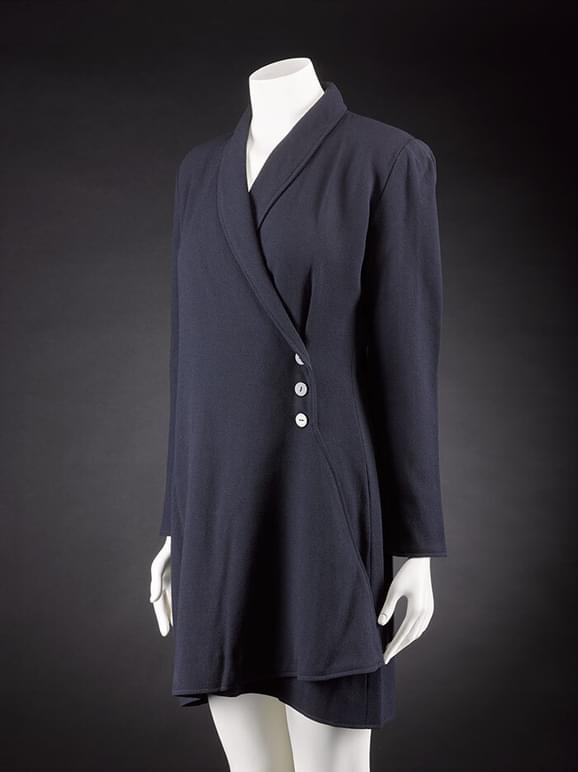
Wool crêpe jacket, probably 1980s. Museum reference K.2005.649.1391.
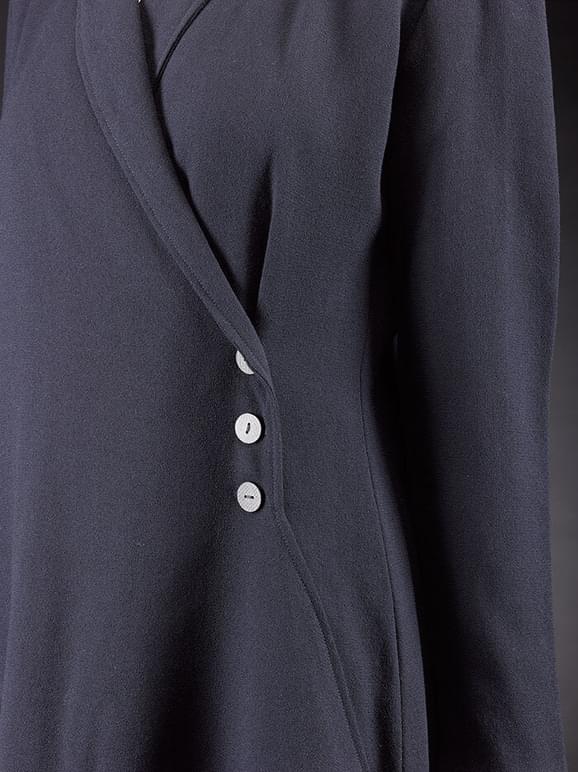
Detail of wool crêpe jacket, probably 1980s. Museum reference K.2005.649.1391.
8. Soft skins
Muir’s skill for using soft, pliable skins like woven fabric is illustrated by this leather jacket, which falls softly in a feminine, flowing shape. It was working with matte jersey, with its ability to take architectural shapes but to remain restrained and fluid, that taught Muir to work in leather. This jacket features all the classic elements associated with Muir’s designs, with striking contrasting top-stitching, pin-tucking, and statement buttons, mirroring her work in jersey.
I love the actual assembling of the structure, and that has to be as precise as any engineer, in a way.
Jean Muir
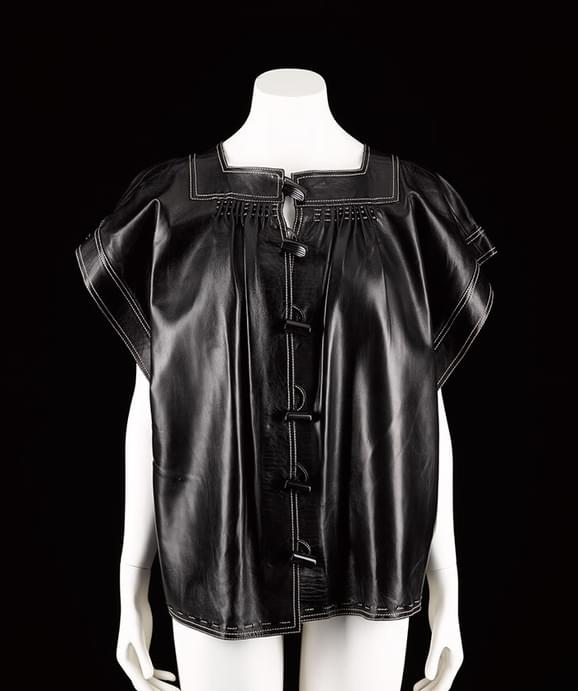
Leather jacket, Spring 1975. Museum reference K.2005.649.590.
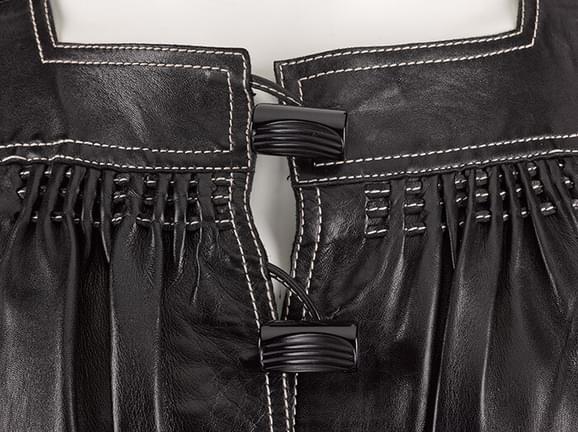
Detail of leather jacket, Spring 1975. Museum reference K.2005.649.590.
9. Printing pattern
Decorative prints were a distinctive element of Muir’s work in suede and leather. The gold pansy print on this imaginatively-cut, electric blue suede shows the versatility of Muir’s suede designs. She favoured soft, pliable skins like fine shirt suede and nappa leather but her manipulation of this stiffer suede illustrates her virtuosity in cutting animal skins.
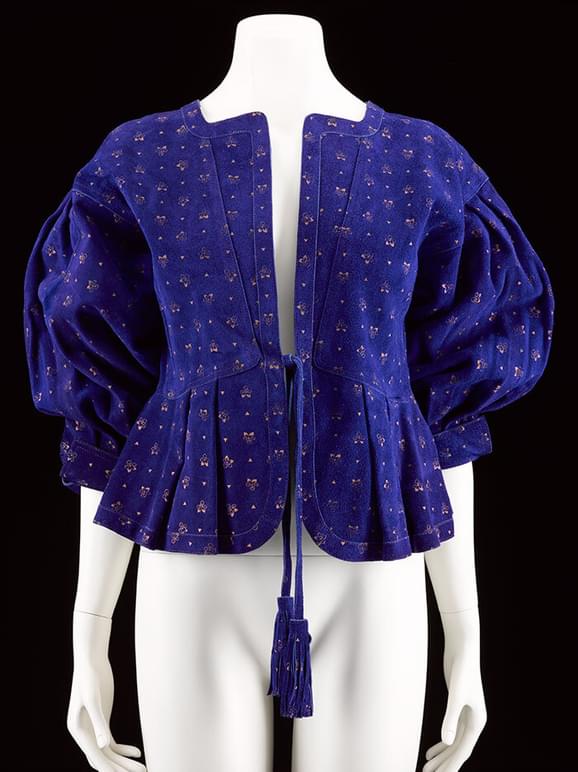
Suede jacket, Autumn/Winter 1982/83. Museum reference K.2005.649.1390.
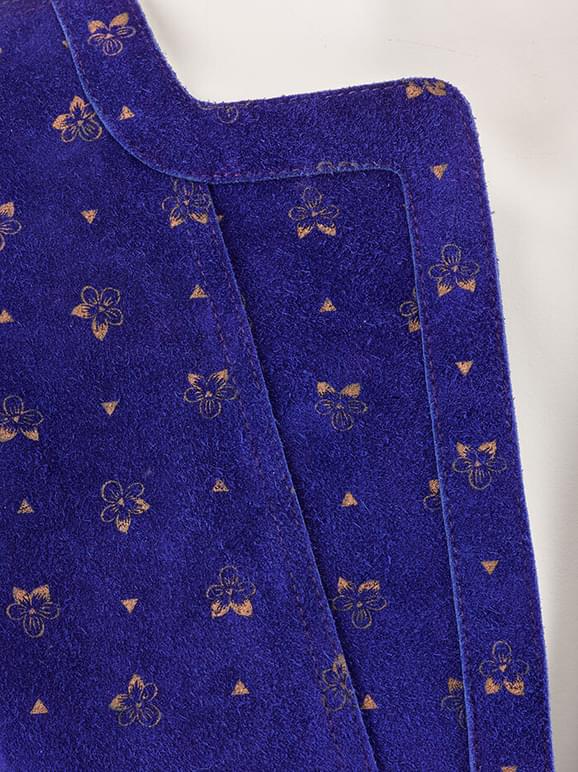
Deatil of suede jacket, Autumn/Winter 1982/83. Museum reference K.2005.649.1390.
10. Working in harmony
Jean Muir frequently commissioned prints for her collections, but she also loved the aesthetic qualities of Liberty fabric. She would often source textiles from the company’s archive, such as the silk used in this dress.
Muir’s printed fabrics were tailored with particular care, so that her fabrics and shapes would work in harmony. This dress combines print with her signature use of decorative acrylic buttons and lines of top-stitching.
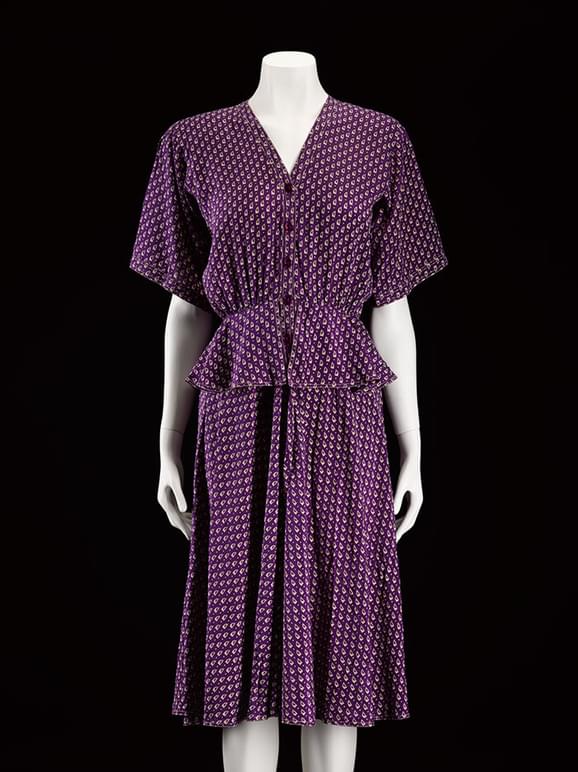
Silk and acrylic dress, Spring Collection 1980. Museum reference K.2005.649.172.
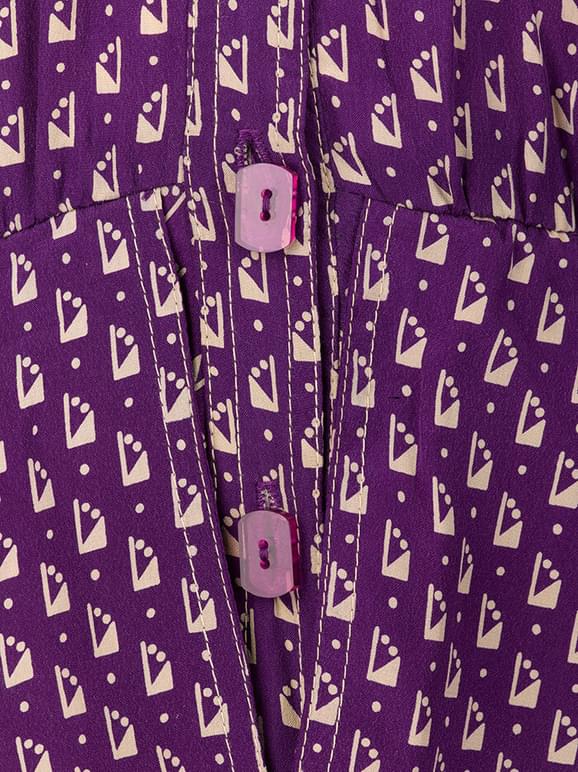
Detail of silk and acrylic dress, Spring Collection 1980. Museum reference K.2005.649.172.
11. Hand crafted fabrics
Creating a Jean Muir collection involved collaborating with many highly skilled craftspeople. Muir saw technical excellence and craft skills as fundamental to turning her ideas into successful clothing.
For this striking coat she worked with Annie Sherburne to create this hand-made felt. The painterly abstract pattern mirrors Muir’s work with intarsia-knitted cashmere sweater dresses and reflects her readiness to inject colour into her wool designs.
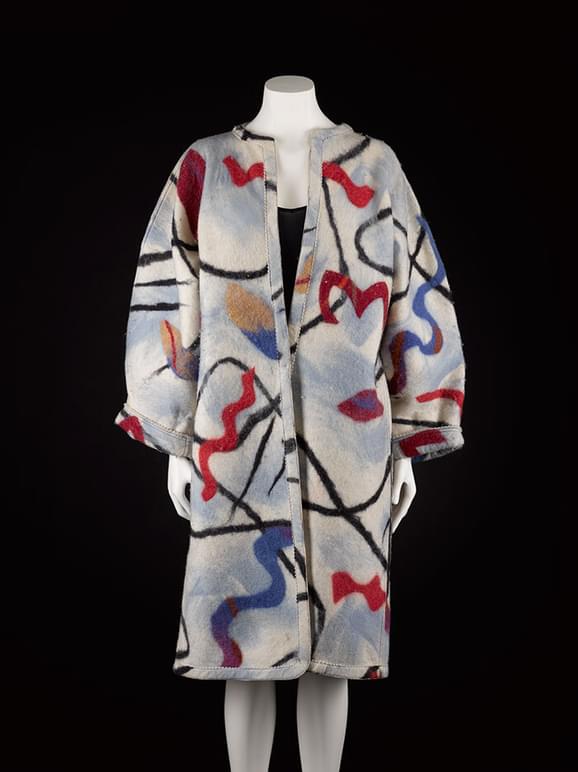
Wool felt coat, 1980s. Musuem reference K.2005.649.20.

Back of wool felt coat, 1980s. Museum reference K.2005.649.20.
12. Painting in cashmere
Muir loved the versatility of wool. Her designs often featured ribbing, cabling, and intarsia, a technique used to create block patterns with multiple colours, without carrying the yarns across the back of the fabric. She was particularly fond of cashmere because it took colour so beautifully. Each season she ordered yarn from the Scottish cashmere specialists, Todd and Duncan.
This intarsia knit sweater features the ‘JM’ signature logo and the abstract faces that recurred often across her collections.
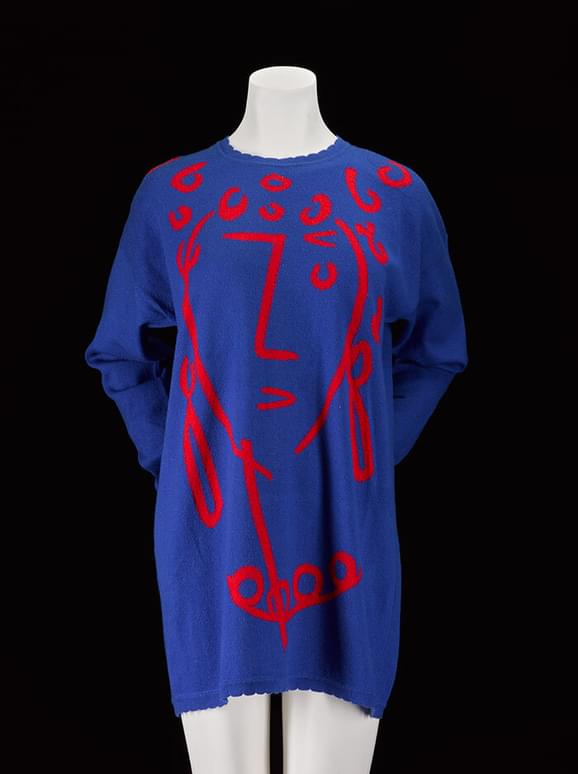
Cashmere sweater dress, early 1990s. Museum reference K.2005.649.752.
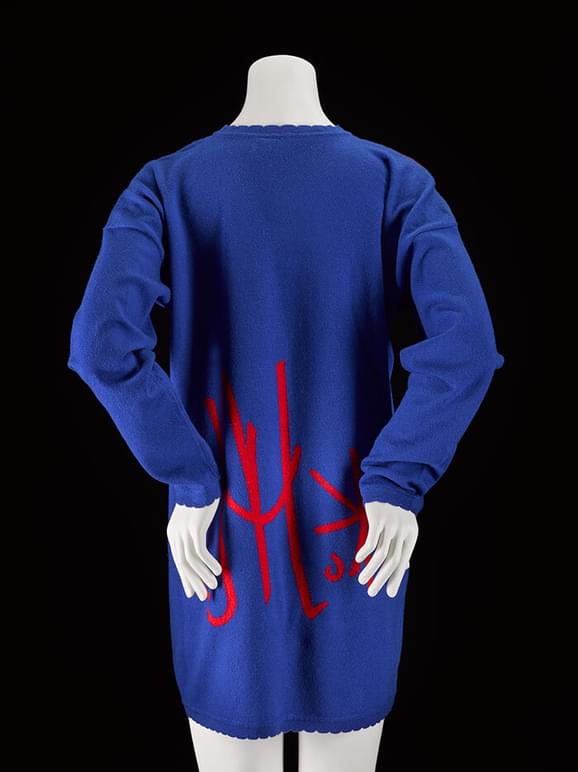
Back of cashmere sweater dress, early 1990s. Museum reference K.2005.649.752.
